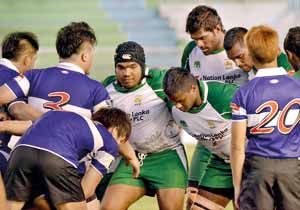WELLINGTON — When you think of Sri Lanka, rugby is not generally something that springs readily to mind. The island nation is certainly better known for cricket, tea exports and its recently ended civil war. But Sri Lanka’s British colonial forefathers left behind more than cricket as a sporting staple.
Rugby was introduced to Sri Lanka in the late 1800s, and today it boasts a large playing population and a television audience of millions.
According to International Rugby Board figures, there are more than 103,000 rugby players in Sri Lanka, making it the second largest rugby-playing nation in Asia, behind Japan.
Eight clubs contest the Caltex League and Clifford Cup, and one match per week is broadcast live during the season. Rugby is also a mainstay of the sporting curriculum at the country’s private schools, and interschool matches regularly draw crowds of several thousand supporters.
 |
| Sri Lankan rugby can also count President Mahinda Rajapaksa among its supporters. Two of his three sons, Yoshitha and Namal, were members of the Sri Lanka team that played in the recent Asian Five Nations Division I tournament in Manila. |
The Bradby Shield, a two-legged annual fixture between Royal College and Trinity College, can draw 20,000 spectators and is watched live on television by millions more. Royal College recently announced a sponsorship deal with KIA Motors that gives the carmaker the branding rights on the jersey of its first XV team.
Sri Lankan rugby can also count President Mahinda Rajapaksa among its supporters. Two of his three sons, Yoshitha and Namal, were members of the Sri Lanka team that played in the recent Asian Five Nations Division I tournament in Manila.
That rugby is so deeply engrained in Sri Lankan society came as a huge shock to Phil Greening, former England hooker and ex-coach of the England Sevens side.
Greening was appointed Sri Lanka’s coach in February. Through business, he had met the Sri Lanka Rugby Union president, Asanga Seneviratne. Greening was then approached by the I.R.B. to see whether he would be interested in helping lower-tier nations develop.
He arrived in Sri Lanka in March to prepare the national team for the Asian Five Nations tournament, which was the start of Asian qualification for the 2015 Rugby World Cup, and to see how the sport could be developed and the standard improved.
“It’s massively followed and massively reported on. I’ve been blown away during the five weeks about how big rugby is there, but also how much scope and growth and development there could be,” Greening said.
“When I met Asanga and he said he was from Sri Lanka, I was like, ‘You play rugby?’ But when you actually look into it, their club rugby gets 5,000, 6,000 people every game,” he continued. “Schools rugby is huge, and Sri Lanka are the second-oldest union in the world. There is a history there that no one knows about.”
But for all the participation, money and media interest, Sri Lanka is still ranked 45th in the world, between the Netherlands and Ivory Coast.
It narrowly missed out on promotion to the 2013 Asian Five Nations Top League after losing 28-18 to the Philippines last weekend.
But Greening believes the right steps are being taken to improve the standard of rugby.
The first was to put the players selected for the Asian Five Nations to the Sri Lanka Rugby Union on contract and to ensure they received everything a professional athlete should.
For many — some of whom were picked for the squad straight out of school — it was the first time they had been given any advice on nutrition and conditioning or had endured the rigors of regular, intense training sessions. Analysis of their matches, training and opposition teams was also new.
“They’ve been absolutely amazing,” said Greening, who played 24 tests for England and is contracted to Sri Lanka for two years. “It’s difficult for them because I’ve come from a professional background where I’ve got certain expectations and standards and they’ve never had it.
“It’s been new to them but very basic for a lot of other professional teams. They’ve loved it.”
But Greening can already see the need to bridge the gap between school, club and international rugby to ensure that the messages about nutrition, conditioning and analysis — staples of the modern international game — filter through.
“It’s still very colonial old-school in a way,” Greening said. “Cricket and rugby are very big. Rugby is their first sport at school. But after that, it loses its way a bit.”
He has suggested setting up a national academy and an elite center. Those ideas have been taken up by Seneviratne, who is also eager to raise Sri Lanka’s profile in world rugby.
Greening admits breaking into the top 20 countries in the world in the midterm in 15s rugby is probably unrealistic. But he does believe quicker progress could be made in sevens rugby, especially now that a shortened form of the game will be played again in the Olympics starting in 2016.
In the buildup to the Rio de Janeiro Games, the HSBC Sevens World Series is expanding the number of tournaments each year, and the Olympics themselves will provide a far bigger audience for rugby.
And with the I.R.B. eager to develop and expand rugby’s brand in Asia, seeking a place on the circuit could be the perfect pathway for Sri Lanka. Another possible avenue would be to hold an Asian Five Nations tournament.
“To have these guys playing on the sevens circuit would be fantastic,” Greening said. “But it’s not just the rugby. They can offer so much. They have the facilities. They have the support. They’ve got two of the president’s sons playing, who are driving development, so they have government support as well.
“Sri Lanka could open up to the rugby community.”
Courtesy New York Times |


